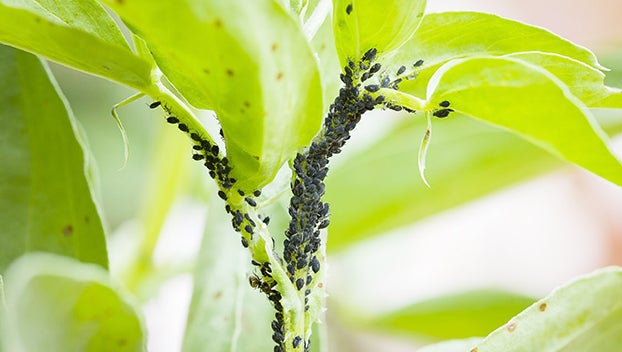TEXAS CERTIFIED EXPERT GARDENER — Manage insect populations by keeping “Bugs” out of the garden
Published 12:02 am Wednesday, March 20, 2024

- Aphids are feasting on the tender new plant growth. Many gardeners don’t realize aphids are born “pregnant” and can begin producing offspring from inception. If unchecked, their population continues growing exponentially, literally extracting the life from plants. (Courtesy photo)
|
Getting your Trinity Audio player ready...
|
Gardening is one of my favorite pastimes, but if I’m being honest, it can be frustrating as well.
Life is hectic, meaning our availability is schedule dependent (for me, literally place holders on multiple calendars) requiring schedule adjustments constantly, but only if a semblance of work-life balance is to be attained.
My gardening tasks tend to be concentrated during weekend time off, which is a limiting factor and forces me to structure gardening tasks efficiently (finish what I start approach to gardening).
Weekend weather patterns depriving me of time outdoors stresses me a bit, self-imposed ‘pressure’ makes me think I’m falling behind on garden chores.
Admittedly, the past rainy weekend was needed, a respite from several weekends of being a “weekend warrior,” where I typically return to work Monday morning-muscles aching, ant bites galore, scratched, battered, and bruised (protective gear was worn). Such is the life of a gardener … and this gardener wouldn’t have it another other way.
There are ways to repel insects which from the smorgasbord gardeners provide them to feast upon yearly mostly during the Spring and Summer months. There are three main methods which can aid us in managing pests in our gardens: chemical, organic and biological. Method effectiveness always begins with insect identification.
Chemical: A word of caution before choosing the chemical method as there is an associated risk when applying (spraying) the product on growing vegetables, as this may contaminate them during the growth cycle.
Know your foe … to determine which insect is the problem, chemicals are not all-inclusive and do not work on all pests. Read the containers information, noting insects listed which should include the problem pest.
Pesticides when applied incorrectly are sources of environmental contamination and toxic to humans, fish, amphibians, livestock and pets. Everyone MUST use them responsibly and carefully, following the manufacturer’s directions.
Be a mindful gardener, consider the protection of bees and all other pollinators. Bees are needed for pollinating fruit and vegetable crops, as well as most ornamental plants.
It is important to note application of a pesticide is also crucial: do not use it during the day when pollinators are searching for and collecting pollen. Late afternoon or evening application is best.
Organic & Biological: It is my recommendation to always begin with a minimally invasive, environmentally conscious (beneficial insect-pollinator friendly) approach before adopting chemical methods which I find to be extreme measures.
Organic and biological solutions to manage insect populations (effecting the bad guys alone) is the most eco-friendly approach. For biological pest control, I’ve purchased beneficial insects and released them into garden and livestock areas.
Remember once they have destroyed the pests, they will not remain. There are numerous beneficial insects for different pests but choosing this method of insect control can quickly become cost prohibitive and results may take longer (first-hand experience-this was not a cost-effective management approach: temperature dependent with spotty efficacy).
Every year my flower gardens and vegetable beds are interplanted with herbs as companion plants from the chart which help to reduce insect populations.
Some gardeners would rather use a spray instead of planting herbs, and there are several products available that are organic and safe to use. Neem oil and horticultural soap are two which I use often in my vegetable gardens, flowers beds, and inside the greenhouse.
Both works very well at eradicating soft bodied insects such as aphids, white flies, thrips, mealy bugs, and mites for a short time but have minimal effect on the “good guys,” beneficial insects including pollinators.
The best insecticidal soap to use is pure-castile liquid soap, which is not a detergent, such as liquid dish detergent. This recipe is for a gardener sprayer application using:
1 gallon water, 2 ½ tablespoons pure-castile liquid soap, and 1 tablespoon vegetable oil. Fill a gallon-size sprayer with water, add soap and oil. Mix well by shaking before using.
The oil allows the soap solution to remain in place longer after being sprayed. Use the entire sprayer contents in one application, then clean the sprayer. For smaller batches (quart size): use 1 teaspoon pure-castile liquid soap & oil per quart water.
Let’s go out and grow ourselves a greener, more sustainable world, one plant at a time!
Send Certified Texas Expert Gardener John Green your questions and please continue sending comments to jongreene57@gmail.com.





